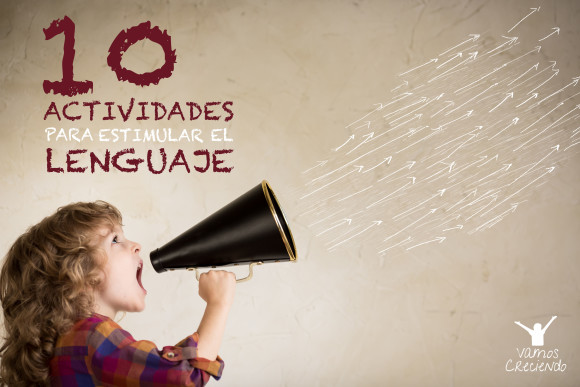When language development refers, every child is a world. We have already commented on occasion that some children can not compare with others because everyone is different.
I personally do not like talking about concrete to develop skills you determine age because I think that depends on multiple factors.
What is clear is that the language may even affect the development of intelligence. In fact I discussed that topic in the post "How it affects the language to the intelligence of children and how to stimulate". Therefore, taking as a starting point what already said at the time, what today are going to give 10 specific activities to stimulate language.
Activities to stimulate language.
- Build questions.
When your little indicate by raising the voice that is asking a question but does not change the order of the words, tell him the right way as a model. If question: "Dad at home?", you tell him: "Is Dad at home? And The, Dad is at home ". Remember to avoid saying things like, "So do not say".
- Tell me a story.
Stories are a great way to stimulate language also come great to work values, hygiene, etc. Leedle a simple and interesting story, if possible you have chosen it. Explicadle illustrations and ask him to describe what he sees in them.
You can ask simple questions about the story to know if you've heard.
The time of reading is a very important moment. Interestingly, always the same time of day for us to establish a routine. If conseguis it an enjoyable and fun time the child will eventually ask you that little bit.
It is quite possible that at first your child does not pay much attention. A good way to grasp is telling the story turns, for example, a page each. Then you can gradually increase the time listening or reading time meanwhile, That depends on the goal you please meet with the activity.
- Different orders.
Give the child simple instructions on objects or ideas that are very familiar: "Bring me your book and close the toy box", the "Bring the ball and closes the door". Recompensadle with positive reinforcement. If the child does not carry out the orders, realizadlas with him, praising him as helps you to comply.
You can start with a command and when the child is able to fulfill add another.
When you go to explain the orders, Tell him you want to listen carefully and do what you have described him as you said. See that the activities fun. If you include leaps and bounds surely love them.
A good way to assure that you have correctly understood what you have explained to you is to ask you to repeat it before you do.
- My name is ...
Make him questions like: "What is your name?", "What is your name, Pedro?", "What's your full name? Peter R…."" What is your name? Peter Ro ... ". "What's your full name? ¿Peter? Did Peter do? ¿Pedro Rodr ...?” ¡Oh, Pedro Rodríguez!".
Tell the small your full name. Juan Rodriguez and mother is Ana Perez.
Occasionally: call by his full name to go understanding that has name.
- Questions with "how".
When performing common activities do him questions such as: "How are we going to the store?", "How do we open the door?". No reply tell him the answer. Gradually you can gradually increase the difficulty of the questions with less common questions.
When you read stories or illustrations shall see, do him questions about the characters and story: "How did he do it?", "How did it get there?".
Gradually you can gradually increase the complexity of the questions and ask him about future actions, "How are you going to open the door?".
- Correct use of tenses.
Utilizad regular forms of the past tense to talk when you describáis action that has already occurred, slightly emphasizing the last termination.
You can use words like "jump, to go up, run "and make the action together. Then ask him to tell what he did or what you did. If he does not use the past, Tell it again and make me repeat.
After doing activities of daily living, like going to the park, to the store or for a walk, ask him to talk about what you have done using the past.
You can also ask questions about future actions.
- What are you doing?
While little is busy doing something, ask him what he is doing. Then, when finished, ask Him to describe what you just did.
You can also ask me explain what other family members. "What was the grandfather?", "What did Mom?".
- How is this used ...?
Teach him an object: a hammer, a ball, pair of scissors, thread, etc. and ask him: "What we do with this?".
You can also teach artwork instead of objects. If you do not know the answer decídsela. Later, ask him again: "What we do with this?". "We cook in a kitchen".
- The imperative.
Ask him the child that you do favors using the imperative and exaggerating "please" and "thank you". Do you imitate that.
You can play "shops". First you can be the buyer. Ask different items using the imperative of different verbs. Then you can switch roles, causing the child to be the buyer.
It is important that the imperative little use when you need something. Insist on to say "please" and "thank you".
- Shares of several steps.
Expressing action sequences often difficult for kids. Ask Him to observe when realicéis action. Subsequently me explain what you have done. If you find it difficult to Help him a little: "I first jumped, then I ... "
Then ask him to be he who perform the actions. Having done by me explain what he has done.
You can also take turns. He made the first action and you the second.
I hope these activities will yield something useful and will serve to promote the language of the kids in the house.
“Learning is finding out that something is possible.”
Fritz Perls
Tags: activities, stimulate, ideas, language, Children



 Español
Español English
English Français
Français Deutsch
Deutsch 中文(简体)
中文(简体) Português
Português
